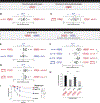C. elegans males optimize mate-preference decisions via sex-specific responses to multimodal sensory cues
- PMID: 38471505
- PMCID: PMC10965367
- DOI: 10.1016/j.cub.2024.02.036
C. elegans males optimize mate-preference decisions via sex-specific responses to multimodal sensory cues
Abstract
For sexually reproducing animals, selecting optimal mates is important for maximizing reproductive fitness. In the nematode C. elegans, populations reproduce largely by hermaphrodite self-fertilization, but the cross-fertilization of hermaphrodites by males also occurs. Males' ability to recognize hermaphrodites involves several sensory cues, but an integrated view of the ways males use these cues in their native context to assess characteristics of potential mates has been elusive. Here, we examine the mate-preference behavior of C. elegans males evoked by natively produced cues. We find that males use a combination of volatile sex pheromones (VSPs), ascaroside sex pheromones, surface-associated cues, and other signals to assess multiple features of potential mates. Specific aspects of mate preference are communicated by distinct signals: developmental stage and sex are signaled by ascaroside pheromones and surface cues, whereas the presence of a self-sperm-depleted hermaphrodite is likely signaled by VSPs. Furthermore, males prefer to interact with virgin over mated, and well-fed over food-deprived, hermaphrodites; these preferences are likely adaptive and are also mediated by ascarosides and other cues. Sex-typical mate-preference behavior depends on the sexual state of the nervous system, such that pan-neuronal genetic masculinization in hermaphrodites generates male-typical social behavior. We also identify an unexpected role for the sex-shared ASH sensory neurons in male attraction to ascaroside sex pheromones. Our findings lead to an integrated view in which the distinct physical properties of various mate-preference cues guide a flexible, stepwise behavioral program by which males assess multiple features of potential mates to optimize mate preference.
Keywords: C. elegans; mate choice; mate preference; neurogenetics; pheromones; sexual behavior; sexual dimorphism.
Copyright © 2024 The Authors. Published by Elsevier Inc. All rights reserved.
Conflict of interest statement
Declaration of interests The authors declare no competing interests.
Figures







Update of
-
C. elegans males optimize mate-choice decisions via sex-specific responses to multimodal sensory cues.bioRxiv [Preprint]. 2023 Apr 8:2023.04.08.536021. doi: 10.1101/2023.04.08.536021. bioRxiv. 2023. Update in: Curr Biol. 2024 Mar 25;34(6):1309-1323.e4. doi: 10.1016/j.cub.2024.02.036. PMID: 37066192 Free PMC article. Updated. Preprint.
References
-
- Darwin C (1871). The descent of man, and selection in relation to sex (J. Murray; ).
-
- Rosenthal GG (2017). Mate choice : the evolution of sexual decision making from microbes to humans (Princeton University Press; ).
Publication types
MeSH terms
Substances
Grants and funding
LinkOut - more resources
Full Text Sources
Research Materials
Miscellaneous

